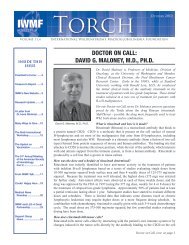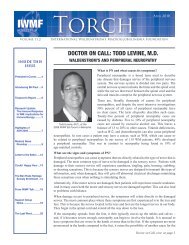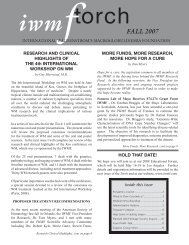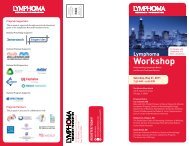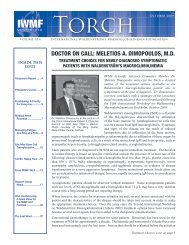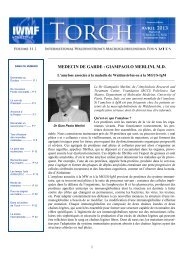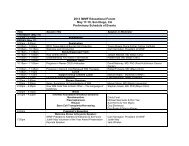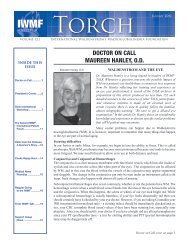SURVIVORSHIP IN CANCER - International Waldenstrom's ...
SURVIVORSHIP IN CANCER - International Waldenstrom's ...
SURVIVORSHIP IN CANCER - International Waldenstrom's ...
Create successful ePaper yourself
Turn your PDF publications into a flip-book with our unique Google optimized e-Paper software.
MEDICAL NEWS ROUNDUP<br />
by Sue Herms<br />
Phase I Trial Combines Bortezomib and Alvocidib – A<br />
Phase I clinical trial of bortezomib and alvocidib (flavopiridol),<br />
a cyclin-dependent kinase inhibitor, evaluated dose-limiting<br />
toxicities and maximum tolerated dose in patients with multiple<br />
myeloma, indolent lymphoma, and mantle cell lymphoma. In<br />
this study, 16 patients were treated. The maximum tolerated<br />
dose was established as 1.3 mg/m 2 for bortezomib and<br />
30 mg/m 2 for alvocidib. Common toxicities included low<br />
white blood cell counts as well as fatigue, febrile neutropenia,<br />
and elevated AST (aspartate aminotransferase) levels. Two<br />
complete responses and five partial responses were observed<br />
for an overall response rate of 44%.<br />
Millenium Pharmaceuticals Investigates Subcutaneous<br />
Bortezomib – Millenium Pharmaceuticals investigated<br />
subcutaneous administration of bortezomib in two clinical<br />
trials in multiple myeloma patients. One trial, a Phase III<br />
study, involved 222 patients: one cohort received bortezomib<br />
as an IV push and the second received it by injection into the<br />
abdomen and thighs. The dosage was 1.3 mg/m 2 for both<br />
groups. Similar efficacy was seen between the groups, but<br />
the incidence of peripheral neuropathy was less in patients<br />
receiving subcutaneous injections: 38% vs. 53% receiving IV<br />
infusion. The U.S. Food and Drug Administration has not yet<br />
approved subcutaneous administration of bortezomib.<br />
Newer Anti-CD20 Antibody Attains Orphan Drug<br />
Designation – AME-133v, a fully humanized anti-CD20<br />
monoclonal antibody, has been granted orphan drug designation<br />
for the treatment of follicular lymphoma. A Phase I/II clinical<br />
trial with AME-133v for 67 patients with previously treated<br />
follicular lymphoma established a recommended dose of<br />
375 mg/m 2 . AME-133v has been engineered for better affinity<br />
to the CD20 receptor on B-cells and increased antibodydependent<br />
cell-mediated cytotoxicity (ADCC), which may<br />
lead to more effective killing of targeted B-cells.<br />
Study Reports Stem Cell Transplantation for WM – The<br />
Blood and Marrow Transplant Program at the University<br />
of Minnesota Medical School released a report on stem<br />
cell transplantation for WM. The report concludes that<br />
autologous stem cell transplantation should be reserved<br />
for chemotherapy-responsive WM patients, particularly for<br />
those in whom duration of the first remission is less than two<br />
years and in patients with intermediate- or high-risk factors<br />
according to the <strong>International</strong> Prognostic Scoring System<br />
for WM (IPSSWM). The study also recommended avoiding<br />
autologous transplant in patients with chemo-refractory<br />
disease and heavily pre-treated patients with more than three<br />
lines of previous therapy. Younger, relatively healthy patients<br />
with short remissions, high-risk IPSSWM score and elevated<br />
LDH could be considered for autologous transplant with<br />
curative intent. Increasing experience with reduced-intensity<br />
allogeneic (mini-allo) stem cell transplant suggests that this<br />
type of transplant could be extended to the elderly, those<br />
with co-morbidities, and those who have relapsed following<br />
autologous transplant. However, allogeneic transplantation<br />
should be performed in experienced transplant centers within<br />
the context of controlled clinical trials.<br />
Project Investigates WM and Risks of Second Cancers –<br />
A joint project by the Cook Children’s Health Care System,<br />
Dana-Farber Cancer Institute, the University of North<br />
Texas Health Science Center, and Cancer Centers of North<br />
Carolina-Asheville investigated site-specific relative risks of<br />
second primary malignancies among patients with primary<br />
WM. Data from population-based registries identified 1,521<br />
patients with primary WM diagnosed between 1973 and<br />
2007. This group yielded 226 second primary malignancies,<br />
and higher site-specific relative risks were observed for colon,<br />
lung, other non-Hodgkin’s lymphoma, myeloma, and acute<br />
myeloid leukemia, compared to the general U.S. population.<br />
The investigation also stated that the higher relative risks of<br />
second primary hematologic malignancies may be treatmentrelated<br />
or immunologically-related, whereas the higher<br />
relative risks of second primary solid tumors may be the<br />
result of detection bias or risk factors shared between WM<br />
and the specific solid tumors.<br />
New Bcl-2 Inhibitor Investigated – The investigational<br />
drug navitoclax (ABT-263) has shown significant activity<br />
in patients with heavily pre-treated chronic lymphocytic<br />
leukemia. In a Phase II study, the drug reached an objective<br />
response rate of 33%. Navitoclax inhibits the protein Bcl-2,<br />
which regulates apoptosis (programmed cell death).<br />
Japanese Study Detects Chromosome Deletion in<br />
WM – The Tokyo Medical University in Japan performed<br />
cytogenetic and FISH analyses on nine patients with WM<br />
and demonstrated deletions of chromosome 20q in four of<br />
nine patients (44%) at diagnosis. Moreover, one patient had<br />
appearance of a 20q deletion after chemotherapy, although<br />
this patient did not have it at diagnosis. The study concluded<br />
that chromosomal breakage at 20q is a non-random genetic<br />
change which plays a role in the neoplastic process of WM.<br />
Pixantrone Tested in Combination Therapy in Phase I<br />
Trial for NHL – Pixantrone was included in a Phase I study<br />
of combination therapy with fludarabine, dexamethasone,<br />
and rituximab in 28 patients with relapsed or refractory<br />
indolent non-Hodgkin’s lymphoma. Pixantrone administered<br />
at 120 mg/m 2 was identified as the recommended dose in this<br />
regimen. The overall response rate was 89%, and the main<br />
adverse events were low white blood cell counts. Estimated<br />
survival was 96% after one year and 92% after three years.<br />
Medical News Roundup, cont. on page 17<br />
16 IWMF TORCH Volume 12.4



